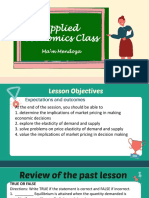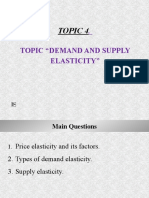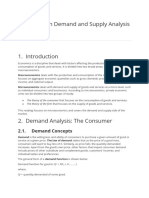Price Elasticity: Demand Measures The Responsiveness of The Quantity Demanded To A Given Price Change
Price Elasticity: Demand Measures The Responsiveness of The Quantity Demanded To A Given Price Change
Uploaded by
Prerna GillCopyright:
Available Formats
Price Elasticity: Demand Measures The Responsiveness of The Quantity Demanded To A Given Price Change
Price Elasticity: Demand Measures The Responsiveness of The Quantity Demanded To A Given Price Change
Uploaded by
Prerna GillOriginal Description:
Original Title
Copyright
Available Formats
Share this document
Did you find this document useful?
Is this content inappropriate?
Copyright:
Available Formats
Price Elasticity: Demand Measures The Responsiveness of The Quantity Demanded To A Given Price Change
Price Elasticity: Demand Measures The Responsiveness of The Quantity Demanded To A Given Price Change
Uploaded by
Prerna GillCopyright:
Available Formats
Price elasticity
In this case, the two key words are 'price' and 'demand', so the price elasticity of
demand measures the responsiveness of the quantity demanded to a given
price change.
Note - Price elasticity of demand is generally known as elasticity of demand .There is
no difference between price elasticity of demand and elasticity of demand. By the
term elasticity of demand, we generally refer to price elasticity of demand;
because, price of a commodity is the most important factor that affects its demand.
The demand elasticity formula calculates the impact of a change in price for a given
product on demand. The law of demand merely explains the qualitative relationship
while the concept of elasticity of demand analyses the quantitative price-demand
relationship.
Price elasticity of demand (e
p
) = Percentage change in quantity demanded /
Percentage change in price
Symbolically,
Ed = %change in quantity demanded
% change in price
PED = (Q/Q)/(P/P) ;
Alternatively PED = (Q/Q) (P/P)
By rearranging PED = (Q/P) (P/Q)
Illustration 1:
The percentage decrease in the price of the commodity is 25% and the percentage
increase in the quantity demanded is 50%.
Hence,
e
p
= 50%/-25% = -2
Note that the price elasticity is always negative because of the inverse relationship
between price and quantity demanded (law of demand). However, as a conventional
way, we ignore the negative sign when calculating the price elasticity.
Illustration 2:
(a) When the price of oranges is $5, the quantity demanded is 20 KGs.
(b) When the price of oranges is $4, the quantity demanded is 24 KGs.
Thus, P = 5, Q = 20; P = 1, Q = 4
e
p
= (Q/P) (P/Q) = (4/1) (5/20) = 1
Note -Instead of the term percentage change, we can use the term proportionate
change also.
Therefore,
e
p
= Proportionate change in quantity demanded / Proportionate change in price
Understanding Elastic and Inelastic
Price Elastic Demand:
Definition: Demand is price elastic if a change in price leads to a bigger % change in
demand; therefore the PED will therefore be greater than 1.
Elastic Demand PED >1 Perfectly Elastic PED =
Goods which are elastic tend to have some or all of the following characteristics.
1. They are luxury goods, e.g. sports cars
2. They are expensive and a big % of income e.g. sports cars and holidays
3. Goods with many substitutes and a very competitive market. E.g. if Sainsburys put
up the price of its bread there are many alternatives, so people would be price
sensitive.
Price Inelastic Demand
These are goods where a change in price leads to a smaller % change in demand;
therefore PED <1, for example PED= 0.5
Inelastic demand PED <1 Perfectly inelastic PED =0
Goods which are inelastic tend to have some or all of the following features:
1. They have few or no close substitutes, e.g. petrol, cigarettes.
2. They are necessities, e.g. if you have a car, you need to keep buying petrol, even if
price of petrol increases
3. They are addictive, e.g. cigarettes.
4. They cost a small % of income or are bought infrequently.
NOTE-In the short term demand is usually more inelastic because it takes time to
find alternatives.
If the price of chocolate increased demand would be inelastic because there are no
alternatives, however if the price of mars increased there are close substitutes in the
form of other chocolate therefore demand will be more elastic.
Degrees / Kinds / Types of price elasticity of demand
The price elasticity of demand can be any value between zero and infinity
If Price Elasticity of Demand = 0, then demand is perfectly inelastic. This
means that demand is not affected by price changes (the demand curve in
this instance is vertical).
If Price Elasticity of Demand = between 0 and 1, then demand is
inelastic. This means that the demand change will be proportionately smaller
than the price change.
If Price Elasticity of Demand = 1, then demand is unit elastic. This means
that the increase in price would result in the same decrease percentage in
demand.
If Price Elasticity of Demand is greater than 1, then demand is elastic
and it is more than proportionately affected by a change in price.
Numerical
Value
Terminology Description
Shape of
the
Demand
Curve
Examples
1. Price
Elasticity =
Perfectly elastic
A consumer
will buy all the
quantity of
the
commodity at
this price and
nothing else
at some other
price.
Horizontal --
2. Price
Elasticity = 0
Perfectly
inelastic
Demand
remains
unchanged
whatever be
the change in
price
Vertical Medicines
3. Price
Elasticity = 1
Unitary elastic
% Q = %
P
Rectangular
hyperbola
--
4. 0 < Price
Elasticity < 1
Inelastic
% Q < %
P
Flatter
Essential
goods
5. > Price
Elasticity > 1
Elastic
% Q > %
P
Steeper
Luxuries
and
comforts
Percentage change in quantity demanded divided by percentage change
in price.
The percentage of change in quantity demanded is: [QDemand(NEW) -
QDemand(OLD)] / QDemand(OLD)
The percentage of change in price is: [Price(NEW) - Price(OLD)] /
Price(OLD)
You might also like
- Electrical Equipment Wholesaling in The US Industry ReportDocument36 pagesElectrical Equipment Wholesaling in The US Industry Reportmichaelkim7No ratings yet
- A Level SyllabusDocument46 pagesA Level Syllabusprudence100% (1)
- Economics for CFA 2024: level 1 in just one week: CFA level 1, #4From EverandEconomics for CFA 2024: level 1 in just one week: CFA level 1, #4Rating: 4.5 out of 5 stars4.5/5 (2)
- Total Utility (TU)Document5 pagesTotal Utility (TU)Prerna Gill100% (2)
- Business StrategyDocument22 pagesBusiness StrategyNgọc KhánhNo ratings yet
- A level Economics Revision: Cheeky Revision ShortcutsFrom EverandA level Economics Revision: Cheeky Revision ShortcutsRating: 3 out of 5 stars3/5 (1)
- Colour Theory - MakeupDocument22 pagesColour Theory - MakeupPrerna Gill86% (14)
- Elasticity of DemandDocument11 pagesElasticity of Demandahmedd346No ratings yet
- Chapter 3 Elasticity of DemandDocument18 pagesChapter 3 Elasticity of Demandmutindiemmaculate97No ratings yet
- Price Elasticity of DemandDocument5 pagesPrice Elasticity of DemandManoj KNo ratings yet
- Elasticity of DemandDocument8 pagesElasticity of Demandgyanendra_paudelNo ratings yet
- Applied Economics - 1st-QRTR - PPT - 5Document63 pagesApplied Economics - 1st-QRTR - PPT - 5Agnes RamoNo ratings yet
- Elasticity of DemandDocument29 pagesElasticity of Demandcyril george100% (1)
- Price Elasticity of DemandDocument14 pagesPrice Elasticity of DemandSergioNo ratings yet
- Logic HumDocument10 pagesLogic Humapi-3709182No ratings yet
- Various Methods of Price Elasticity of DemandDocument9 pagesVarious Methods of Price Elasticity of Demandsalim132150% (2)
- Elasticity of Demand: Price, Income and Cross ElasticityDocument59 pagesElasticity of Demand: Price, Income and Cross Elasticitynithinsp92No ratings yet
- Elasticity of Demand and SupplyDocument27 pagesElasticity of Demand and SupplyMuskan FatimaNo ratings yet
- Chapter No 1Document16 pagesChapter No 1Daima Surgical InstrumentNo ratings yet
- Chap 2 Elasticity and Its Application Part 3Document48 pagesChap 2 Elasticity and Its Application Part 3The TwitterNo ratings yet
- Types of Elasticity of Demand Price Elasticity of DemandDocument19 pagesTypes of Elasticity of Demand Price Elasticity of Demandanisul1985No ratings yet
- Elasticity of Demand and SupplyDocument17 pagesElasticity of Demand and Supplyarnavagrawal64No ratings yet
- Elasticity of DemandDocument5 pagesElasticity of DemandEarl CopeNo ratings yet
- Elasticity and Its ApplicationDocument6 pagesElasticity and Its ApplicationSavannah Simone PetrachenkoNo ratings yet
- Man Eco - Lesson 3Document3 pagesMan Eco - Lesson 3kayedelacruz90No ratings yet
- Lecture 03 - Elasticity of Demand and SupplyDocument60 pagesLecture 03 - Elasticity of Demand and SupplyTanveer Khan100% (2)
- Price Elasticity of DemandDocument4 pagesPrice Elasticity of Demandm7mdasus4060No ratings yet
- Unit-II ELASTICITY OF DEMAND (ALL)Document20 pagesUnit-II ELASTICITY OF DEMAND (ALL)stevesilasrockersNo ratings yet
- Price Elasticity Week 5Document38 pagesPrice Elasticity Week 5Katrina LabisNo ratings yet
- Concept of Elasticty and Its Application (+ Handwritten Notes Too)Document41 pagesConcept of Elasticty and Its Application (+ Handwritten Notes Too)Aishwarya ChauhanNo ratings yet
- Me 4pptDocument55 pagesMe 4pptarchana_anuragiNo ratings yet
- ElasticityDocument58 pagesElasticityAryan AggarwalNo ratings yet
- Elasticities of Demand-Class Lecture For B.Com MBA AmityDocument26 pagesElasticities of Demand-Class Lecture For B.Com MBA AmityMandira banjareNo ratings yet
- Types of Price Elasticity of DemandDocument5 pagesTypes of Price Elasticity of DemandNelluri Surendhar ChowdaryNo ratings yet
- Elasticity of Demand and Supply: ObjectivesDocument11 pagesElasticity of Demand and Supply: ObjectivesJoanne FerrerNo ratings yet
- Elasticity of Demand.Document20 pagesElasticity of Demand.Gamaya Emmanuel100% (1)
- Elasticity (Economy)Document42 pagesElasticity (Economy)Весна ЛетоNo ratings yet
- Unit 2.2 Elasticity of Demad and SupplyDocument21 pagesUnit 2.2 Elasticity of Demad and SupplyPrerak ShresthaNo ratings yet
- Santosh Bhandari Assignment1Document18 pagesSantosh Bhandari Assignment1Santosh BhandariNo ratings yet
- AppliedEconomics - Q3 - Mod4 - Market PricingDocument15 pagesAppliedEconomics - Q3 - Mod4 - Market Pricingrebecca tanaidNo ratings yet
- R12 Topics in Demand and Supply AnalysisDocument40 pagesR12 Topics in Demand and Supply AnalysisNeeraj KatewaNo ratings yet
- Elasticity in EconomicsDocument38 pagesElasticity in Economicsmuhammad ali100% (1)
- Market Demand and ElasticitiesDocument46 pagesMarket Demand and Elasticitiespdm88hd4bsNo ratings yet
- Economics CT2Document192 pagesEconomics CT2EE19B1004 ADENA VISHNU VARDHAN REDDYNo ratings yet
- Be 313 - Unit Learning CDocument19 pagesBe 313 - Unit Learning Cmhel cabigonNo ratings yet
- The Concept of ElasticityDocument11 pagesThe Concept of ElasticityMark Lawrence Lorca FortesNo ratings yet
- Elasticity of DemandDocument20 pagesElasticity of DemandManvendra Shahi100% (1)
- Elasticity of DemandDocument44 pagesElasticity of Demandashutoshshukla832004No ratings yet
- Demand: K.S. Narayana Asst - Professor Department of Mechanical Engineering Gitam Visakhapatnam Andhra Pradesh - IndiaDocument32 pagesDemand: K.S. Narayana Asst - Professor Department of Mechanical Engineering Gitam Visakhapatnam Andhra Pradesh - IndiaRajKumarNo ratings yet
- Elasticity of DemandDocument12 pagesElasticity of DemandYashraj NigamNo ratings yet
- Topic - ELASTICITY OF DEMAND PDFDocument19 pagesTopic - ELASTICITY OF DEMAND PDFShilpaNo ratings yet
- Elasticity of DemandDocument28 pagesElasticity of Demandshweta3547No ratings yet
- Elasticity of Demand PDG FinalDocument68 pagesElasticity of Demand PDG FinalManav SonejaNo ratings yet
- Price Elasticity of DemandDocument4 pagesPrice Elasticity of DemandMADmanTalksNo ratings yet
- Elasticity of DemandDocument13 pagesElasticity of DemandArmando Delos SantosNo ratings yet
- Chap 4 ElasticityDocument14 pagesChap 4 ElasticityLâmViênNo ratings yet
- Elasticity of DemandDocument7 pagesElasticity of DemandLakshmiRengarajan100% (2)
- Bec Module 3Document3 pagesBec Module 3cheskaNo ratings yet
- Elasticity of DemandDocument6 pagesElasticity of DemandayaanecommercestoreNo ratings yet
- Naveena SamaDocument19 pagesNaveena SamaSägñîk KàtårïNo ratings yet
- Elasticity of DemandDocument62 pagesElasticity of DemandVikku Agarwal100% (1)
- Lecture 2 Elasticity of Demand and SupplyDocument61 pagesLecture 2 Elasticity of Demand and SupplyJoanne FerrerNo ratings yet
- H A N A M I L L Y: - Warm Up - Arms + Core - Stretch & Relax 40 - 1h 40 - 1h 40 - 1hDocument1 pageH A N A M I L L Y: - Warm Up - Arms + Core - Stretch & Relax 40 - 1h 40 - 1h 40 - 1hPrerna GillNo ratings yet
- When Total Utility Is at Its Maximum Where Is Marginal Utility?Document1 pageWhen Total Utility Is at Its Maximum Where Is Marginal Utility?Prerna GillNo ratings yet
- The Ketogenic WorkoutDocument2 pagesThe Ketogenic WorkoutPrerna Gill50% (2)
- Paradox of ValueDocument2 pagesParadox of ValuePrerna GillNo ratings yet
- Study Note - The Basic Economic Problem: Scarcity and ChoiceDocument5 pagesStudy Note - The Basic Economic Problem: Scarcity and ChoicePrerna GillNo ratings yet
- Stock Supply 1. MeaningDocument8 pagesStock Supply 1. MeaningPrerna GillNo ratings yet
- Fill in The BlanksDocument14 pagesFill in The BlanksPrerna Gill0% (1)
- Food SecurityDocument7 pagesFood SecurityPrerna GillNo ratings yet
- Why Marginal Utility of Money Is Constant in Marshalls Analysis?Document1 pageWhy Marginal Utility of Money Is Constant in Marshalls Analysis?Prerna GillNo ratings yet
- Central Problems of An EconomyDocument10 pagesCentral Problems of An EconomyPrerna GillNo ratings yet
- Second Law of GossenDocument2 pagesSecond Law of GossenPrerna GillNo ratings yet
- Demand Test 23rd SeptDocument1 pageDemand Test 23rd SeptPrerna GillNo ratings yet
- ICICIdirect Model Portfolio ProductDocument54 pagesICICIdirect Model Portfolio ProductPrerna GillNo ratings yet
- Makeup Secrets RevealedDocument25 pagesMakeup Secrets RevealedPrerna Gill100% (2)
- Report On Summer Placement Project (2010 - 2012 Batch) : ResearchDocument4 pagesReport On Summer Placement Project (2010 - 2012 Batch) : ResearchPrerna GillNo ratings yet
- AcknowledgementDocument6 pagesAcknowledgementPrerna GillNo ratings yet
- Branding With Special Reference To: The Intellectual Property ActDocument31 pagesBranding With Special Reference To: The Intellectual Property ActPrerna GillNo ratings yet
- Handout EntrepDocument6 pagesHandout EntrepNorsaifah AbduljalalNo ratings yet
- Digitally Signed by Mahesh Arvind Kulkarni Date: 2023.11.04 16:11:48 +05'30'Document16 pagesDigitally Signed by Mahesh Arvind Kulkarni Date: 2023.11.04 16:11:48 +05'30'kapilNo ratings yet
- Vanessa Joy V. Baluyut Grade Level: 11 Subject: Applied EconomicsDocument2 pagesVanessa Joy V. Baluyut Grade Level: 11 Subject: Applied Economicsvaniique100% (2)
- BOMBACH, G. Manpower Forecasting and Educational PolicyDocument33 pagesBOMBACH, G. Manpower Forecasting and Educational PolicyAndré MartinsNo ratings yet
- Subject Code: 101 Subject: Management Concepts and Application Attempt Any TWO Questions From The FollowingDocument12 pagesSubject Code: 101 Subject: Management Concepts and Application Attempt Any TWO Questions From The FollowingVishalKhuranaNo ratings yet
- EC202-Online-Activity 3Document6 pagesEC202-Online-Activity 3R and R wweNo ratings yet
- Kinked Demand Curve: OligopolyDocument10 pagesKinked Demand Curve: OligopolyREJIN TSNo ratings yet
- 2Document3 pages2dinauy88No ratings yet
- Chapter 3: Simultaneous Equations: Worked Example 3.12Document15 pagesChapter 3: Simultaneous Equations: Worked Example 3.12monicaNo ratings yet
- TPD 501 AssDocument8 pagesTPD 501 AssTomisin EniolaNo ratings yet
- Integrated Zonal-Exchange and Nodal-Flow Clearing Model in Multi-Zonal Spot Electricity MarketsDocument6 pagesIntegrated Zonal-Exchange and Nodal-Flow Clearing Model in Multi-Zonal Spot Electricity MarketsumairNo ratings yet
- Allama Iqbal Open University, Islamabad: (Department of Economics)Document3 pagesAllama Iqbal Open University, Islamabad: (Department of Economics)ilyas muhammadNo ratings yet
- ECO610X AssignmentDocument3 pagesECO610X AssignmentBellindah GNo ratings yet
- Supply and DemandDocument16 pagesSupply and DemandMartin JanuaryNo ratings yet
- Economics Assingment - 1st Sem - Radhika KhaitanDocument20 pagesEconomics Assingment - 1st Sem - Radhika KhaitanSandeep TomarNo ratings yet
- Asgn2-MIcro Economics BBA Part 1 2023Document2 pagesAsgn2-MIcro Economics BBA Part 1 2023waqarsindhi136No ratings yet
- ECO Comic StripsDocument4 pagesECO Comic StripsNurul Izzaty bt Md Zaini100% (1)
- Marketing Management Module 3Document13 pagesMarketing Management Module 3Sharon Cadampog MananguiteNo ratings yet
- Syllabus@PGDM 1st YearDocument84 pagesSyllabus@PGDM 1st Yearmail_garaiNo ratings yet
- Detailed Mba Syllabus: Core CoursesDocument5 pagesDetailed Mba Syllabus: Core Coursessham ctgNo ratings yet
- Handout Industrial EconomicsDocument104 pagesHandout Industrial Economicsabadi gebruNo ratings yet
- Econ7073 2021.S1Document76 pagesEcon7073 2021.S1RebacaNo ratings yet
- Operations - Burger KingDocument11 pagesOperations - Burger Kingslezhummer100% (1)
- Test+Full+O R +++ABC+++Service+SectorDocument4 pagesTest+Full+O R +++ABC+++Service+SectorSameer AhmedNo ratings yet
- Trade Competitiveness and Export Performance of inDocument9 pagesTrade Competitiveness and Export Performance of insheraaz87No ratings yet
- Aggregate Planning & Pricing at Mintendo (Toys R Us)Document2 pagesAggregate Planning & Pricing at Mintendo (Toys R Us)hina firdous0% (1)
- Answer ALL The Questions in Section A and TWO Questions From Section BDocument6 pagesAnswer ALL The Questions in Section A and TWO Questions From Section BTom WongNo ratings yet












































































































